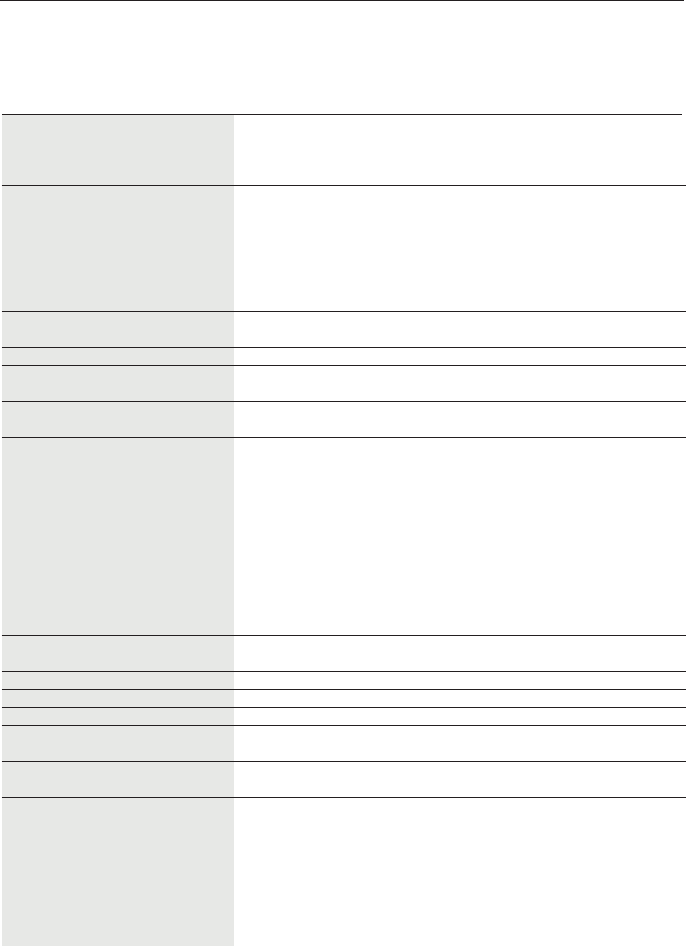
14
LCD Module Diagonal: 22.0 inch Active matrix; thin fi lm transistor (TFT)
Viewable Image Size: 22.0 inch liquid crystal display (LCD); 0.282 mm dot
Native Resolution (Pixel Count): 1680 x 1050 pitch; 300cd/m
2
white luminence;
900:1 contrast ratio, typical
Input Signal PC INPUT
Video: ANALOG 0.7 Vp-p/75 Ohms Digital Input: DVI
Sync: Separate sync TTL Level (Positive/Negative)
Horizontal sync Positive/Negative
Vertical sync Positive/Negative
AUDIO INPUT STEREO Mini Jack
500mV rms Input Impedance 14 Kohm
Head Phone Output STEREO Mini Jack
Headphone Impedance 32 Ohm
Display Colors Analog input: 16.7M Depending on display card used.
Maximum Horizontal: 176° (CR>5)
Viewing Angles Vertical: 176° (CR>5)
Synchronization Horizontal: 31.5 kHz to 82.3 kHz Automatically
Range Vertical: 56 Hz to 75 Hz Automatically
Resolutions Supported 720 x 400*1 : VGA text Some systems may not support
640 x 480*1 at 60 Hz to 75 Hz all modes listed.
800 x 600*1 at 56 Hz to 75 Hz
832 x 624*1 at 75 Hz
1024 x 768*1 at 60 Hz to 75 Hz
1152 x 864*1 at 60 Hz to 75 Hz
1152 x 870*1 at 75 Hz
1280 x 960*1 at 60 Hz to 75 Hz
1280 x 1024*1 at 60 Hz to 75 Hz NEC DISPLAY SOLUTIONS cites
1440 x 900*1 at 60 Hz recommended resolution at 60 Hz for
1680 x 1050 at 60 Hz ........................... optimal display performance.
Active Display Area Horizontal : 473.8 mm/18.7 inches
Vertical : 296.1 mm/11.7 inches
Power Supply 100-240 V ~ 50/60 Hz
Current Rating 0.95-0.55A/100-240V
Speakers Practical Audio Output: 1+1 watts
Dimensions 505.2 mm (W) x 390.9 mm (H) x 221.8 mm (D)
19.9 inches (W) x 15.4 inches (H) x 8.7 inches (D)
Weight 5.2 kg
11.5 lbs
Environmental Considerations
Operating Temperature: 5°C to 35°C/41°F to 95°F
Humidity: 30% to 80%
Altitude: 0 to 15,000 Feet
Storage Temperature: -10°C to +60°C/14°F to 140°F
Humidity: 10% to 85%
Altitude: 0 to 40,000 Feet
Monitor AccuSync
Specifi cations LCD224WXM Notes
*1 Interpolated Resolutions: When resolutions are shown that are lower than the pixel count of the LCD module, text may appear
different. This is normal and necessary for all current fl at panel technologies when displaying non-native resolutions full screen. In fl at panel
technologies, each dot on the screen is actually one pixel, so to expand resolutions to full screen, an interpolation of the resolution
must be done.
NOTE: Technical specifi cations are subject to change without notice.
Specifi cations


















